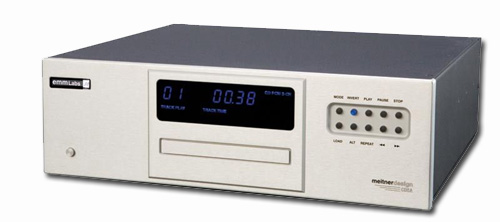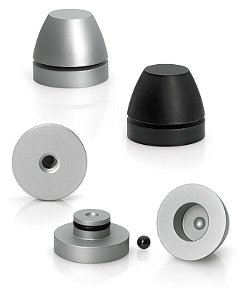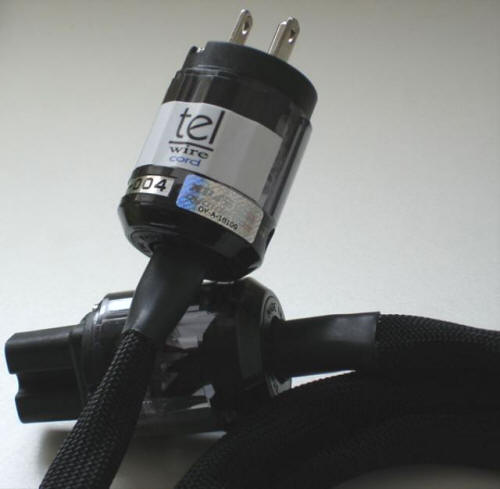
You are reading the older HTML site
Positive Feedback ISSUE
may/june 2008
emm labs
CDSA CD/SACD player - A follow-up with the new transport and feet upgrade
as reviewed by Ryan Coleman

|
Intro
If you've been enjoying my reviews for some time let me say I admire your taste. All kidding aside, in writing Part 2 of my EMM CDSA, I had to go back and read my original review again (Part 1 can be found at dagogo.com. This is a follow-up with the new transport and feet upgrade and not a full review!), and I found that I stand by every word I wrote. Despite the fact that I fell for the unit hard, I still took issue with a number of items and purchased the review sample in spite of its flaws (which every component has). Specifically, I felt the unit had a transport that was unbecoming of a $10k CD player. It was perfectly reliable, but it was flimsy and hardly inspired confidence. While it was impossible to quantify what effect the transport had (or didn't have) on the sound, I wondered openly during the review if the lack of reach and impact in the bass was because of its inadequate heft. In other listening sessions with other gear, I found the Esoteric XO1-D2 had no problems generating the deepest bass I've heard from a digital player, matched only by the Wadia 861SE. What was the common thread between the two units? The Esoteric VRDS transport is found in both, and the build quality of the VRDS transport makes other transports seem like Fisher Price toys in comparison. The EMM CDSA, with its superior sonic performance, used a transport that was more akin to a stock-keeping unit in Toys 'R Us than those found in the Esoteric or Wadia. I was only left to wonder how much things would improve if the unit had a heftier transport.
Happily, those days are past. EMM has come up with a few changes in an upgrade available to CDSA owners: new machined feet, new software, and a new transport. Lets walk through the changes, shall we?
First, Optimizing the EMM CDSA
Having lived with the unit for a considerable period, I've found various tweaks along the way to get the most out of it. First and foremost: that power switch on the back? Put it into the "On" position unless you're going on vacation. The unit takes a few days to come to life, and there's no sense in compromising it by cycling it on and off. It's not a class A component, so it draws little power and generates no heat. Just leave it on, and you'll be sure to get its best performance every time. But for you compulsive types (like me), if you simply have to do something to reduce the sensation that the units on, then turn off the display via the remote control. I find this to be the best solution because the display is off, and if there's no disc playing, the laser is off too. The only risk you have is via power surges / lightning strikes, but that's what fuses and breaker boxes are for.
Secondly, the unit has proven exceedingly
sensitive to vibration control. Vibration control, more than any other
factor in audio playback, is hit or miss. Some systems are very
susceptible to it, and some are immune; perhaps this is because
vibration sensitivity is a function of the components themselves, the
rack they sit on, the proximity to the speaker, or any/all of the
above. Vibration can be in either the horizontal plane (which is easily
addressed with products like Ceraballs or Rollerblocks) or in the
vertical plane (see offerings from Silent Running Audio, Vibraplane,
etc). Despite a sturdy and well-engineered rack by Ultrasonic, I found the EMM Labs CDSA to be susceptible to both horizontal
and vertical vibration.
It performed significantly better when I put together my homebrew
isolation system: a barely inflated 12" inner tube underneath a 2" thick
maple butcher's block (vertical
 isolation), and then Finite Element Ceraballs (horizontal isolation) on the maple, and the CDSA on top the
Ceraballs. Image height rose a few feet (measured from the front wall),
image density and body was more holographic, and low level details took on
their own space and were much more easily picked out of the mix. Really, all three of these improvements were a function of one thing:
improved detail retrieval. One must always try to get every last bit of
information from the software being played back; if there's increased
brightness or some other problem as a result of additional details, then
you've a problem elsewhere in your system, but don't blame it on the
messenger! Anyway, for $150, this was one of the best tweaks I have ever
used. Give it a try, and if it does work, bear in mind the professional
products will work much better.
isolation), and then Finite Element Ceraballs (horizontal isolation) on the maple, and the CDSA on top the
Ceraballs. Image height rose a few feet (measured from the front wall),
image density and body was more holographic, and low level details took on
their own space and were much more easily picked out of the mix. Really, all three of these improvements were a function of one thing:
improved detail retrieval. One must always try to get every last bit of
information from the software being played back; if there's increased
brightness or some other problem as a result of additional details, then
you've a problem elsewhere in your system, but don't blame it on the
messenger! Anyway, for $150, this was one of the best tweaks I have ever
used. Give it a try, and if it does work, bear in mind the professional
products will work much better.
AC cabling is another area that one should always address in order to optimize any component. The thing about the EMM CDSA is that I find the product so damn good in its overall tone and harmonic presentation that cabling, usually employed by audiophiles as tone controls for flawed electronics, needs to be as unobtrusive as possible. Given that I didn't want to upset the delicate and ideal balance I was hearing, I found the best cord for the job was newcomer TelWire's sole offering ($799). While being exceedingly neutral throughout the midrange but with excellent extension at the frequency extremes, the cord is also highly flexible and very light, allowing for more effective isolation of horizontal and vertical vibrations, a pursuit which paid big dividends for my playback as I mentioned earlier.

And finally, one must always keep the unit up to date with a factory supplied upgrade to the software revision, downloadable from EMM's web site.
Think about this for a moment. I'm not talking about upgrading software for Microsoft Windows or Office, I'm talking about upgrading the software for a CD player! How many other high-end audio companies do you think have upgrades to their digital decoding algorithm, installable via a PC UBS cable? Methinks not many. Any dealer will upgrade the software as part of the upgrade kit, but I was very impressed by how easy it was to self install the upgrade. If you are familiar with installing software on a home computer, you shouldn't have any trouble (whereas a qualified dealer or the factory should do the upgrade to the transport assembly).
I honestly wasn't expecting much from the new software, but that could simply be a function of my never having experienced an upgrade to the software of a digital player I used (which, though stated in my original review, bears repeating: the EMM CDSA is heavy on brains). While not as substantial an improvement as the transport/feet combo, the new software provided a very audible improvement in the extraction of staging cues, harmonic decay and upper frequency air (which are all related to low level detail). The software revision, much like the transport upgrade (to be covered shortly), provided improved low level detail that gave rise to a greater sense of image density and depth within the soundstage. While the original CDSA was a staging champ, the software revision further enhanced the sensation of "bodies defined in space" as opposed to other players that simply present a general blob-like location of musicians. With the additional low level detail, its not surprising that harmonic decay was improved as well. I always felt the CDSA was the most tonally correct digital player I had ever encountered; the software revision simply extended that tonal rightness a bit further into the mix, giving life to those incredibly complex but barely audible overtones from a struck piano key. Finally, the software upgrade provided a bit more air around the instruments, such as the air around the chains rattling under a snare drum, or the distinction between strings within the piano box. In sum, this was a very audible upgrade and I highly recommend it given its price is, oh, free!
Upgraded Transport + Feet
This is a job for the professionals, so plan on sending the unit to your dealer (or the factory) for them to accomplish. The original feet were just some simple plastic jobbers found on any low-fi piece of equipment, but the new ones are obviously machined and have a non-resonant filler within them, and are more befitting a component of this quality. However, the discussion of feet pales in comparison to the discussion of the transport change. The original transport, an OEM from Philips, was replaced with a (more or less) drop in substitute of much better quality. While still not up to the heroic construction standards of a VRDS transport, the new unit is one for which no apologies need be made. It has the look and feel of a solid drawer, with much greater rigidity to any twisting or vibration.
The differences were not subtle, and I was not struggling to hear them. As I wrote in my original review, the CDSA got negative marks for bass depth and impact that was not up to state-of-the-art standards (as defined by the Esoteric XO1-D2 in my experience). Well, the new transport made significant improvements in just these parameters, allowing a drum kit to extend lower and with a greater percussive feel. Additionally, while I was very much pleased with the leading edge of the stock unit, feeling it defined the attack without the overemphasis often found in inferior players (a characteristic which, along with an elevated treble balance, gives rise to "digititis"), the upgraded transport gave a bit more snap to the leading edge. This is a point worth elaborating on. In comparing solid-state amps and tube amps, I've found the former to emphasize attack and linearity while the latter emphasized musicality, but it was seldom the two in equal measures within any component. Prior to the upgrade, if forced to I'd have categorized the CDSA more on the "tube amp" spectrum of the above continuum, but after the transport upgrade, it is now more evenly balanced, treading that rare ground that gives rise to both the attack and the musicality. In other words, the unit has seen its sense of PRAT (pace, rhythm, and timing) improve quite significantly, while still maintaining that tonal truthfulness that made the CDSA such a godsend for vinylphiles and others who abhor the sterile sound of digital audio.
An additional improvement that was easily predicted from the use of a sturdier (which can easily be read as "more resistant to vibration") transport was the ability of the unit to extract even more details than before. Given how good the original unit was in this regard, I was surprised to hear those additional low level details that were heretofore obscured to me. What was interesting was that the net effect of this was greatly improved imaging and soundstaging. And this makes sense when you think about it. When you add detail, you're really adding information both about the performance and the venue of the recording. The unit has always gotten the performance and the venue, but the lowest level details are in the reverberation of the studio / recording hall, and extracting this information helps place performers in space.
Taken as a whole, the upgrade to the transport has taken what is arguably the finest single-box digital player up another notch or two.
Conclusion
With the upgraded transport and latest software revision, I'm fast running short of things to gripe about with this unit. Oh sure, I wish it had digital inputs, and perhaps a more ego-laden remote, but after that? Sheesh, with the new transport and software, I'm thinking the bass depth and impact are a smidge less than that from the best I've heard on CD playback, and while the original CDSA was the pinnacle of detail retrieval, the upgrade only extends its lead on the competition. PRAT is greatly improved and harmonics are even more complex thanks to the additional information but they retain that even-handedness that defines EMM Labs, and serves notice to competitors as to what digital playback should aspire to be.
EMM Labs has taken a statement product, a standard in the industry, and made it better. Correction: lots better. The cutting edge just got sharper, folks. Anyone who has lain down 10-large can feel comfortable that the $1500 for the upgrade will be money well spent. Ryan Coleman
CDSA CD/SACD player
Retail: $10,000 + $1500 for upgraded transport/feet
EMM Labs
web address: www.emmlabs.com
